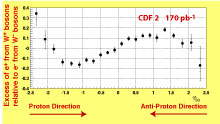 | Thursday, March 31, 2005 |
|
Thursday, March 31 2:30 p.m. Theoretical Physics Seminar - Curia II Speaker: P. Huber, University of Wisconsin Title: Neutrino Properties from Astrophysical Sources 3:30 p.m. DIRECTOR'S COFFEE BREAK - 2nd Flr X-Over 4:00 p.m. Accelerator Physics and Technology Seminar - 1 West Speaker: L. Michelotti, Fermilab Title: CHEF: Progress Report on an Interactive Program for Accelerator Optics
Friday, April 1 |
|
Extended Forecast |
Secon Level 3 |
|
Thursday, March 31 Santa Fe Black Bean Soup Marinara Meatball Soup $4.75 Tex-Mex Lasagna $3.75 Sauteed Liver & Onions $3.75 Baked Ham & Swiss on a Ciabatta Roll $4.75 California Pizza $2.75 Crispy Fried Chicken Ranch Salad $4.75 The Wilson Hall Cafe now accepts Visa, Master Card, Discover and American Express at Cash Register #1.
Wilson Hall Cafe Menu |
| Fermilab Today is online at: http://www.fnal.gov/today/ Send comments and suggestions to today@fnal.gov Fermilab Today archive Fermilab Today PDF Version Fermilab Result of the Week archive Fermilab Safety Tip of the Week archive Linear Collider News archive Fermilab Today classifieds Subscribe/Unsubscribe to |
|
Notes from the March UEC Meeting At the March 5 meeting of the Users Executive Committee, Rob Plunkett presented the status of the NuMI project, including its successful startup, and
- Hirohisa A. Tanaka |
|
March 28 - March 30 - During this 48 hour period Operations established one store that combined with an existing store provided the experiments with approximately 45 hours an 36 minutes of luminosity - Booster suffered from RF problems - Tevatron motion detectors record Sumatra earthquake - Linac experts discover and repair RF station hose leaks - I- Source motor generator failed - Booster vacuum valves close - Antiproton Source emittances affects stacking
Read the Current Accelerator Update |
|
From AScribe, March 29, 2005 Argonne National Laboratory Is Focus of New Alliance Between University of Chicago, Northwestern, University of Illinois CHICAGO, March 29 (AScribe Newswire) -- The University of Chicago has established a new Science Policy Council in collaboration with Northwestern University and the University of Illinois that will oversee the scientific mission of Argonne National Laboratory. The Council is expected to enhance Argonne's scientific capabilities, strengthen the state's technological base and workforce preparation, and improve Illinois' ability to receive federal research funding. read more |
|
What's in a Proton? | ||
| ||
The simple answer from high school physics class is that the
protons in every atomic nucleus are made of two up-type
quarks and one down-type quark, known as valence quarks.
However, a more complete description includes a sea of
Fortunately, the Tevatron also provides opportunities to measure the composition of the proton, described by the parton momentum distribution function (PDF), by measuring the forward-backward asymmetry of leptons from W boson decays. More W+ bosons are produced moving in the same direction as the colliding protons (forward), while W- bosons tend to be produced moving in the opposite direction: the details of this distribution are sensitive to the subtle effects of the sea quarks. A recent paper (PRD RC 71, 051104) from CDF reports a measurement of the W asymmetry with 170 pb-1 of data from Run II, using a new technique to perform silicon tracking close to the beamline. Once incorporated into theoretical models, this new information will lead to more precise measurements in the future at both CDF and DZero. | ||
| ||
|
Result of the Week Archive |
|
Women's Personal Protection and Self Defense Spring Class Due to its success, we will be offering another class session in the spring from April 6 to May 18. Classes are held in Kuhn Barn from 5:30-7:30PM. The cost is $35.00. This class is open to Fermilab women, their mothers and daughters, minimum age is 12, no maximum age. For more information and testimonials from past participants visit the Recreation Office Web site.
Fermi Singers Perform on April 22
|




